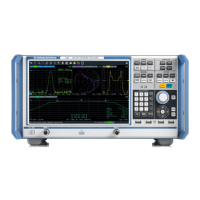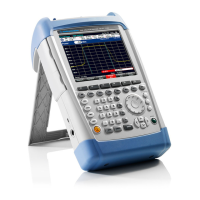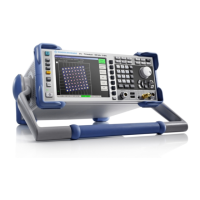R&S
®
ZVA/ZVB/ZVT CALCulate
1145.1084.12 6.55 E-6
Range [def. unit] 2E-012 s to 200 s. The increment (parameters UP or DOWN) is
0.1 ns. [s]
*RST value 5E-009 s
SCPI, Command
Types
Confirmed, command or query
Example:
See CALCulate<Ch/Tr>:FILTer[:GATE]:TIME:CENTer
CALCulate<Ch/Tr>:FILTer[:GATE]:TIME:STARt <numeric_value>
Defines the start time of the time gate.
<Ch/Tr>
Channel number used to identify the active trace
<numeric_value>
Start time of the time gate.
Range [def. unit] –100 s to +99.999999999998 s. The increment
(parameters UP or DOWN) is 0.1 ns. [s]
*RST value –1E-009 s
SCPI, Command Types
Confirmed, command or query
Example:
*RST; CALC:TRAN:TIME:STAT ON;
CALC:FILT:TIME:STAT ON
Reset the instrument and enable the time domain
representation and the time gate.
CALC:FILT:TIME:STAR 0; STOP 10ns
Set the start time to 0 ns and the stop time to 10 ns.
Note: If the start frequency entered is greater than the current stop frequency
(CALCulate<Ch/Tr>:FILTer[:GATE]:TIME:STOP), the stop frequency is set to the start
frequency plus the minimum frequency span
(CALCulate<Ch/Tr>:FILTer[:GATE]:TIME:SPAN).
CALCulate<Ch/Tr>:FILTer[:GATE]:TIME:STATe <Boolean>
Determines whether the time gate for trace no. <Ch/Tr> is enabled.
<Ch/Tr>
Channel number used to identify the active trace
<Boolean>
ON – Time gate enabled
OFF – Time gate disabled
*RST value OFF [–]
SCPI,
Command
Types
Confirmed, command or query
Example:
*RST; CALC:TRAN:TIME:STAT?; CALC:FILT:TIME:STAT?
Reset the instrument, activating a frequency sweep, and query
whether the default trace is displayed in the time domain and whether
the time gate is enabled. The response is 0;0.

